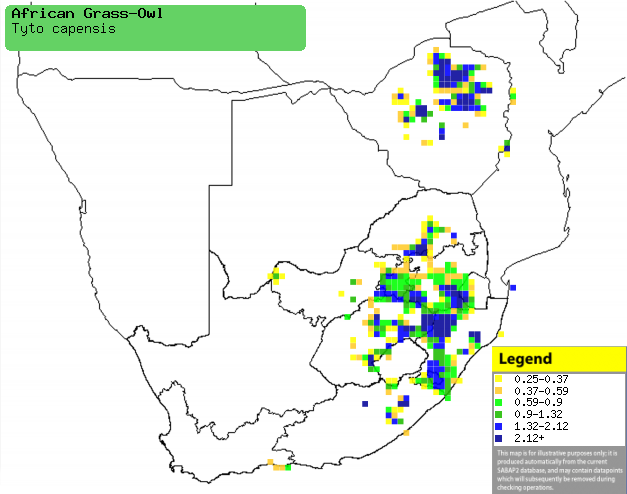|
Tyto capensis (African grass-owl)
Grasuil [Afrikaans]; Isikhova (also applied to Barn owl)
[Xhosa]; isiKhova (also applied to Barn owl), umShwelele [Zulu]; Suunsu (also
applied to Barn owl) [Kwangali]; Sephooko (also applied to Barn owl and Marsh
owl) [South Sotho]; Makgohlo [North Sotho]; Zizi (generic name for owl) [Shona];
Musoho [Tsonga]; Lerubise (also applied to Marsh and Barn owls) [Tswana]; Kaapse
grasuil [Dutch]; Effraie du Cap [French]; Graseule [German]; Coruja-do-capim
[Portuguese]
Life
> Eukaryotes >
Opisthokonta
> Metazoa (animals) >
Bilateria >
Deuterostomia > Chordata >
Craniata > Vertebrata (vertebrates) > Gnathostomata (jawed
vertebrates) > Teleostomi (teleost fish) > Osteichthyes (bony fish) > Class:
Sarcopterygii (lobe-finned
fish) > Stegocephalia (terrestrial
vertebrates) > Tetrapoda
(four-legged vertebrates) > Reptiliomorpha > Amniota >
Reptilia (reptiles) >
Romeriida > Diapsida > Archosauromorpha > Archosauria >
Dinosauria
(dinosaurs) > Saurischia > Theropoda (bipedal predatory dinosaurs) >
Coelurosauria > Maniraptora > Aves
(birds) > Order: Strigiformes
> Family: Tytonidae
Distribution and habitat
Occurs in patches of sub-Saharan Africa, from the Congo and
northern Angola through southern DRC to Tanzania, Zambia, Malawi and southern
Africa. Within southern Africa it is locally common in north-central Zimbabwe,
western Mozambique, Swaziland and
east-central South Africa. It generally prefers marshes and vleis with patches
of tall rank grass, weeds or sedges, but it may also occupy fynbos, renosterveld and
thorn scrub close to water.
|
 |
|
Distribution of African grass-owl in southern Africa,
based on statistical smoothing of the records from first SA Bird Atlas
Project (©
Animal Demography unit, University of
Cape Town; smoothing by Birgit Erni and Francesca Little). Colours range
from dark blue (most common) through to yellow (least common).
See here for the latest distribution
from the SABAP2. |
Predators and parasites
Movements and migrations
Largely resident, although it moves away if
there is a fire or if a temporarily flooded habitat dries up.
Food
Mainly eats rodents, foraging nocturnally by flying low
over the ground, twisting its head in order to locate by sight and sound. Once
prey is located it dives to the ground and picks it up with its talons, feeding
on the ground or on a nearby perch. The following food items have been recorded
in its diet:
- Vertebrates
- Invertebrates
Breeding
- Little known, but probably a monogamous territorial solitary nester.
- The nest is an unlined depression in the ground placed among rank grass.
It creates multiple tunnels through the grass branching out from the nest,
so that it can move around undetected by other predators.
- Egg-laying season is from November-July, peaking from January-April.
- It lays 2-6 eggs, which are incubated solely by the female for about 32
days.
- The chicks are brooded by the female for the first 10 days of their
lives, while the male brings them food; thereafter both sexes have to hunt
to provide for their growing young. At about 28-35 days old they start to
navigate the tunnels through the grass surrounding the nest, learning to fly
at approximately 49-55 days old and becoming fully independent about a month
later.
Threats
Vulnerable in South Africa, largely caused by
habitat degradation through ploughing, grazing, draining and burning; its
population in the country is though to be less than 5000 individuals.
References
-
Hockey PAR, Dean WRJ and Ryan PG 2005. Roberts
- Birds of southern Africa, VIIth ed. The Trustees of the John Voelcker
Bird Book Fund, Cape Town.
|
